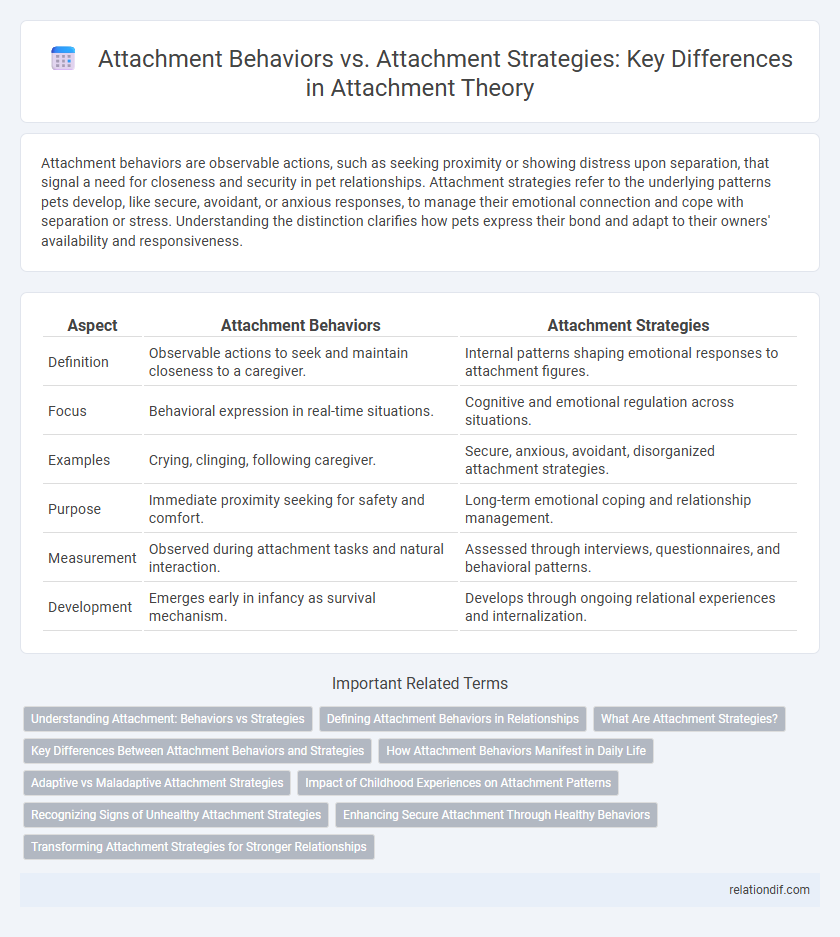Attachment behaviors are observable actions, such as seeking proximity or showing distress upon separation, that signal a need for closeness and security in pet relationships. Attachment strategies refer to the underlying patterns pets develop, like secure, avoidant, or anxious responses, to manage their emotional connection and cope with separation or stress. Understanding the distinction clarifies how pets express their bond and adapt to their owners' availability and responsiveness.
Table of Comparison
| Aspect | Attachment Behaviors | Attachment Strategies |
|---|---|---|
| Definition | Observable actions to seek and maintain closeness to a caregiver. | Internal patterns shaping emotional responses to attachment figures. |
| Focus | Behavioral expression in real-time situations. | Cognitive and emotional regulation across situations. |
| Examples | Crying, clinging, following caregiver. | Secure, anxious, avoidant, disorganized attachment strategies. |
| Purpose | Immediate proximity seeking for safety and comfort. | Long-term emotional coping and relationship management. |
| Measurement | Observed during attachment tasks and natural interaction. | Assessed through interviews, questionnaires, and behavioral patterns. |
| Development | Emerges early in infancy as survival mechanism. | Develops through ongoing relational experiences and internalization. |
Understanding Attachment: Behaviors vs Strategies
Attachment behaviors are observable actions such as seeking proximity, crying, or clinging that infants display to maintain closeness to caregivers, ensuring safety and emotional security. Attachment strategies refer to the underlying patterns developed over time to regulate attachment needs, categorized as secure, avoidant, ambivalent, or disorganized, reflecting how individuals manage closeness and separation. Understanding the distinction between these behaviors and strategies is crucial for recognizing how early interactions influence emotional regulation and relational patterns throughout life.
Defining Attachment Behaviors in Relationships
Attachment behaviors in relationships refer to the instinctual actions individuals use to seek comfort and security from their loved ones, such as proximity seeking, clinging, or vocalizing distress. These behaviors are observable responses aimed at maintaining emotional connection and alleviating feelings of anxiety or threat. Attachment strategies, by contrast, involve the underlying patterns and coping mechanisms developed over time, guiding how attachment behaviors are expressed and regulated within relational dynamics.
What Are Attachment Strategies?
Attachment strategies are consistent patterns of behavior individuals use to maintain or regulate emotional bonds in relationships, shaped by early caregiving experiences. These strategies often involve managing proximity, seeking comfort, or expressing distress in ways that reflect secure, anxious, avoidant, or disorganized attachment styles. Understanding attachment strategies helps clarify how people cope with intimacy, trust, and dependence in social and romantic relationships.
Key Differences Between Attachment Behaviors and Strategies
Attachment behaviors are observable actions such as seeking proximity or distress signals that directly express a child's need for comfort and security from a caregiver. Attachment strategies, however, refer to the underlying patterns or methods developed over time to maintain emotional connection and regulate attachment, often shaped by early experiences and environmental factors. Key differences include that behaviors are immediate responses to attachment needs, whereas strategies represent habitual coping mechanisms developed to manage attachment-related stressors.
How Attachment Behaviors Manifest in Daily Life
Attachment behaviors manifest in daily life through actions like seeking comfort, maintaining proximity, and using a caregiver as a secure base during stress or uncertainty. These behaviors are observable in routines such as greeting rituals, emotional expressions, or physical closeness, reflecting an individual's underlying attachment system activation. Unlike attachment strategies, which are cognitive and emotional patterns developed to manage attachment needs, attachment behaviors are direct, tangible indicators of the attachment bond in real-time interactions.
Adaptive vs Maladaptive Attachment Strategies
Attachment behaviors are observable actions aimed at maintaining proximity and security with a caregiver to ensure safety and comfort. Adaptive attachment strategies promote healthy emotional regulation and secure relationships by addressing needs effectively, while maladaptive attachment strategies involve dysfunctional patterns such as avoidance, ambivalence, or disorganization that hinder emotional development and interpersonal trust. Understanding the distinction between these strategies is crucial for identifying attachment-related challenges and guiding therapeutic interventions.
Impact of Childhood Experiences on Attachment Patterns
Childhood experiences significantly influence attachment behaviors and strategies, shaping how individuals form emotional bonds and respond to relational challenges. Early interactions with caregivers create internal working models that guide attachment patterns, affecting trust, security, and emotional regulation in later relationships. Disruptions or inconsistent caregiving often result in maladaptive attachment strategies, leading to difficulties in intimacy and emotional resilience.
Recognizing Signs of Unhealthy Attachment Strategies
Unhealthy attachment strategies often manifest through patterns of avoidance, ambivalence, or disorganized behaviors that disrupt emotional bonding. Signs include excessive clinginess, emotional withdrawal, or inconsistent responsiveness, reflecting anxiety or mistrust in relationships. Recognizing these behaviors early enables targeted interventions to promote secure attachment and emotional well-being.
Enhancing Secure Attachment Through Healthy Behaviors
Attachment behaviors are natural actions infants display to seek comfort and safety from caregivers, forming the foundation for secure attachment, while attachment strategies are more complex patterns developed over time to maintain emotional bonds. Enhancing secure attachment involves consistently responding to a child's attachment behaviors with sensitivity and warmth, fostering trust and emotional regulation. Healthy attachment behaviors promote resilience and social competence, reducing the risk of maladaptive attachment strategies in later relationships.
Transforming Attachment Strategies for Stronger Relationships
Attachment behaviors are observable actions like seeking proximity and providing comfort, while attachment strategies refer to the underlying patterns developed to maintain emotional security. Transforming attachment strategies involves recognizing and modifying insecure patterns--such as avoidance or anxiety--to foster trust and emotional openness. Strengthening relationships requires consistent practice of secure behaviors, promoting emotional attunement and responsiveness between partners.
Attachment behaviors vs attachment strategies Infographic

 relationdif.com
relationdif.com